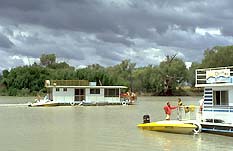
|
| A houseboat on the
Murray-Darling near Wentworth |
Wentworth (including Dareton and Curlwaa)
Major town on the Murray-Darling river junction
Wentworth is an attractive old town located 1047 km west of
Sydney via the Great, Mid Western and Sturt Highways and 37
m above sea-level. The population is currently around 1500.
Wentworth's history is inseparable from its position
where the Murray and Darling Rivers meet. The world's
fourth-largest river system it drains one-fifth of
Australia. Explorer Charles Sturt arrived at the junction in
1830 and identified the Darling as "a new and beautiful
stream coming apparently from the north". He weighed anchor
opposite a tree which he marked. This tree, known as Sturt's
Tree, still retains his imprint and is located by the
riverbank in Willow Bend Caravan Park at the southern end of
Darling St. There is an explanatory plaque.
Sturt was followed by Thomas Mitchell who headed down the
Darling to its junction with the Murray in 1836. After
Joseph Hawdon, Charles Bonney and Charles Sturt overlanded
cattle from Sydney to Adelaide in 1838 other squatters began
to follow them out into the new pastures along the Murray.
The intersection became known as Hawdon's Ford as Hawdon
regularly used it as a spot for driving his stock across the
Murray. This established its central importance as a river
crossing for stockmen headed to Adelaide and the site
gradually became a focal point of the surrounding pastoral
district.
The first settlers at the junction were drovers who
established a camp at the junction in the 1840s. Frequent
and violent conflict arose with the Aborigines. While most
skirmishes were limited there was one ill-publicised
massacre in the area. Leaseholds along the Darling
stipulated that the property owners had to furnish the
Aborigines on the properties with provisions and permit the
hunting of traditional game. When Avoca station fell upon a
period of hardship the bread provision was garnished with
arsenic and the entire tribal group was found dead the next
morning.
The first houses at present-day Wentworth appeared
c.1851. The future of the town was determined when William
Randell's river steamer Mary Ann sailed from Mannum near
Adelaide down the Murray past the Darling junction. He was
hotly pursued and overtaken by Francis Cadell's Lady
Augusta. Randell moved there with his wife and opened a
small general store in 1856 and Cadell opened a trading
store at the junction later that year.
The town soon became an important and commercially
influential river port at the centre of the NSW, Victorian
and South Australian river trade and, effectively, the
capital of the district. Much of the wool clip of
south-western NSW found its way via bullock, donkey and
camel wagon to Wentworth. A wharf was erected by 1860. It
was dismantled in 1982 but a similar red gum wharf was built
in its place.
A survey was made of Hawdon's Ford in 1858. It was
proclaimed as Wentworth in 1859 after William Charles
Wentworth, a significant politician who advocated
self-government, trial by jury and liberty of the press.
In 1860 Wentworth was formally laid out, a police officer
arrived, a postal service was established and a stage coach
service began operating between Wentworth and Mt Murchison.
By the time Wentworth was declared a municipality in 1879 it
was, in fact, the busiest inland port in Australia. In 1895
485 vessels were recorded as passing through the Customs
House with a record 31 in one week alone.
The decline of the river trade as the railway expanded,
and the development of Mildura, halted the town's expansion.
However it remained a service centre to the surrounding
pastoral district and a farm irrigation scheme. Today wool
and fruit remain at the centre of the local economy.
Wentworth Show and Gymkhana is held in August and a
street party in December. There are two golf courses and
those staying at Willow Bend Caravan Park can feed the
brush-tail possums which gather each night.
Things to see:
![[Top of page]](smlArrow.gif)
Aboriginal Heritage
Wentworth has a number of historic sites associated with the
former occupation of the land by the Barkindji people, the
largest tribe in NSW. The best way to see these is through
Harry Nanya Tours, an Aboriginal-owned and operated
eco-tourist venture which offers six different tours. These
incorporate an examination of Perry Sandhills, just off
Renmark Rd, 5 km north-west of town. Covering 10 hectares
these rolling red sandhills date back to the Ice Age (40 000
years ago) and contain evidence of early Aboriginal
occupation, as does Thegoa Lagoon, adjacent. The tours take
in the river junction, Lake Victoria, Lake Mungo, the
Pioneer Museum, Scotia Sanctuary, the river system, canoe
trees, middens, native bush plants, local wildlife,
performances by Barkindji dancers, examples of bushtucker
and an historical view from the Aboriginal perspective,
including insight into the impact of white settlement. Harry
Nanya Tours are located at Shop 10, Sandwych St, tel: (03)
5027 2076. At the same location is Harry Mitchell Art and
Craft Shop, featuring examples of Aboriginal culture.
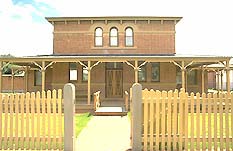
|
| The Wentworth Courthouse
|
Historic Buildings
St John's Church of England was erected in 1871 of stone and
mud mortar with bricks around the edges. Owing to the fact
that it was the first church to be built on the Darling, it
has been classified by the National Trust. Next door to the
Anglican Church is Wentworth State School, some of its
buildings dating back to 1860. Also of historical interest
in Darling St are the post office, the 1885 water tower
(prefabricated in Scotland), the old customs officer's house
and Wentworth Courthouse (1879), a brick building with
timber verandahs.
The old courthouse building, a slab cottage, is also
extant. It is located in Fotherby Park, just over the
Darling River Bridge. Also in the park is the dry-docked
paddlesteamer Ruby, near the junction of the Darling River
and Tuckers Creek. One of the last steamboats engaged in the
passenger and cargo trade, it is currently being restored
and will be moved to a position alongside the new wharf.
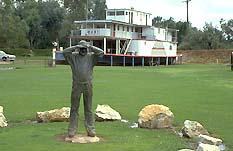
|
| The Possum Man with the
MS Ruby in the background on the banks of the
Darling River |
The statue in the park is a monument to a local legend.
The inscription reads: 'David James Jones 1901-1982. A will
o' the wisp nomadic recluse who lived for 54 years in the
bushland downstream of Wentworth'. Jones was known as 'The
Possum' because he often slept in trees. Nearby are the
remnants of the old Wentworth Bridge and bits and pieces of
old agricultural equipment. Also in the park is a bunya
pine, the seeds of which were much sought after by the
Australian Aborigines.
Aboriginal Canoe
If you cross the bridge to the southern side of Tuckers
Creek and take the road to the hospital on your immediate
right you can park your car and walk across to the northern
bank of the Murray where there is a canoe tree - one in
which a section of bark has been removed for the
construction of an Aboriginal canoe. If you walk westwards
along the narrow stretch of land between the two rivers
towards the river junction there is a walking path through a
wildlife reserve.
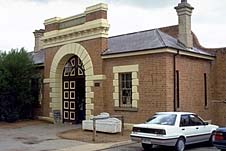
|
| Wentworth Gaol
|
Wentworth Gaol
The old Wentworth Gaol is considered the best example of a
small Victorian gaol in NSW. It was built from 1879-1891 of
a million locally-made bricks with bluestone trim from
Victoria and slate brought from Wales as ship's ballast. It
was a small but notoriously harsh prison for more serious
offenders with 10 male and 2 female cells, massive 45-cm
thick walls, lookout towers, a stretching rack, a whipping
stool, stocks, and shackles set into a boulder in the
unshaded centre of the courtyard. The gaol closed down in
1929. Today it houses the Morrison collection of antique
bottles, gemstones, minerals and Australiana and a statue of
Harry Nanya, his partner and their child. Harry Nanya, who
died around 1880, was one of the last fullblooded,
free-roaming Aborigines of the local tribe. The prison is
open every day from 10-5 in Beverley St, near the
intersection with Francis St, tel: (03) 5027 3337.
Wentworth Museum
On the other side of Beverley St is the Museum. Open from
10.00am - 5.00pm daily it has 3000 items including fossil
remnants found at Perry Sandhills of extinct Australian
megafauna, including the diprotodon (a sort of giant wombat)
and a giant kangaroo. There are also replicas of some of
these animals situated in a diorama. The museum also has an
unusual redgum tree trunk. When it was cut down in 1971 it
was found that the tree had grown around and entirely
engulfed another tree stump which had been felled with an
axe. The inner tree has been dated at 200 years. There is
also an enormous mural, several pieces of locally-found
space junk from satellites dating back to the 1960s and some
interesting and antiquated machinery, including an example
of the world's first outboard motor.
Monument to a Tractor
There is a monument to the Ferguson tractor at the corner of
Adelaide and Adams Sts. This is probably the only monument
to a tractor in Australia. It commemorates the saving of the
town in 1956. During that year the floods rose to a point
where the entire town was threatened. The locals, with the
help of about 35 Ferguson tractors, worked day and night for
months to build levee banks. It is widely accepted that
these levee banks saved the town.
War Memorial
The town hall wall in Adelaide St has an unusual war
memorial - a wooden roll of honour made by a German internee
during World War II. It is fashioned into a book with leaves
that turn and a wooden bookmark.
St Ignatius High School
St Ignatius High School, restored by the National Trust, is
situated on the northern bank of the Murray at the corner of
Short and Cadell Sts. Opened in 1911 it was run by the
Sisters of Mercy until it became a kindergarten in 1925.
Further west along Cadell St is a nunnery built by
Wentworth's first mayor, William Gunn, in 1892.
William Gunn also built what is the oldest-surviving
private residence in the district, Rendelsham House, which
dates back to 1868. Located on the corner of the Silver City
Highway and Adams St it is now privately owned and, so, can
only be viewed from outside.
Junction of the Darling and Murray Rivers
Those wishing to have a good look at the river junction can
access a viewing tower at Junction Park. Turn left off
Cadell St as you head west and turn into Alice St, following
it to the riverbank. It was here that former prime minister
Bob Hawke launched his Environmental Statement Policy by
planting ten red gums as part of his billion-tree program -
a major replanting effort intended to replace the millions
that had been cut down since European arrival.
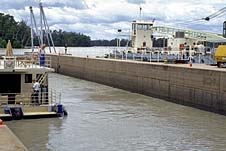
|
| At Weir and Lock Number
10 which is 820 km from the mouth of the
Murray-Darling and 30.8 m above sea level
|
Lock Number 10 and Weir
To see Lock Number 10 and Weir (built in 1929) go all the
way to the end of Cadell St where there is also a boat ramp.
Opposite is the cemetery. The river system is ideal for
power boating, fishing, rowing, waterskiing and houseboats
(available for hire locally ).
You can take a first-hand look at the features of the
river system by taking a two-hour cruise on the MV Loyalty,
built at Goolwa in 1914. It is the oldest propellor-driven
riverboat operating in Australia today, The Loyalty was used
as a milk boat until it became a passenger vehicle in the
1950s, tel: (03) 5027 3330 or 019-331192. It departs at 1.45
every day bar Saturday from the rear of the Wentworth
Services Club car park off Darling St.
Dareton
If you cross the bridge over Tuckers Creek and follow the
Silver City Highway east for 12 km you will come to the
small township of Dareton. It is well worth stopping to have
a look at Tulklana Kumbi Aboriginal Galleries at 33 Neilpo
St, where there is a guided tour of the premises, tel: (03)
5027 4691.
About 6 km east of Dareton along the Silver City Highway,
to your left, is the Stanley Wine Company, open for
inspections and wine tastings every day until 4 pm, tel:
(03) 5023 4341.
Orange World and Australian Inland Botanical Gardens
Almost directly opposite is Orange World where you can take
a tractor train tour through their orange, mandarin,
grapefruit, lemon and avocado orchards. It then returns to
their packing centre and nursery where there is an
informative talk about how to grow citrus at home, how to
test fruit in the shops and a look at their own processing
procedures. The tour takes about an hour and operates twice
daily every day but Saturday. For further information phone
(03) 5023 5197.
Orange World is situated on the corner of the highway and
River Rd. Turn into the latter and it will lead you to the
Australian Inland Botanical Gardens (well signposted), open
from 10-4 every day except Saturday. Return to the highway
and follow it to the small township of Buronga. From here
head east along the Sturt Highway.
Gol Gol
A few kilometres will bring you to Gol Gol. There is a
walking track on the right that follows the river to Drings
Hill where there is an ancient Aboriginal midden. You can
also take a tour of the yabbie farm at Gol Gol Fisheries
(Carramar Drive, tel: 03-5024 8613). There is a hatchery,
yabbie fishing in season, yabbie races, cooked yabbies, free
train rides, refreshments and barbeque facilities. Another 6
km along the highway (towards Euston and Robinvale) is
Trentham Estate Winery and Restaurant at Trentham Cliffs,
tel: (03) 5024 8888.
Lake Nearie and Mungo National Park
58 km north, off the Silver City Highway, is Lake Nearie
where there is a nature reserve with plenty of birdlife and
macropods. This road will take you on to Broken Hill.
Wentworth is also a good jumping-off point for Mungo
National Park (see entry on
Lake Mungo). There are two routes. Head east along the
Silver City Highway. Just before you reach the outskirts of
Buronga turn left into Arumpo Rd (unsealed) and follow the
signposts. Alternatively you can take one of two turnoffs
from the Wentworth-Poonacrie road.
Scotia Sanctuary
Scotia Sanctuary is a wildlife reserve situated in the arid
outback of far western New South Wales. Amidst the mallee
sand dunes are a range of birds, mammals and reptiles. The
reserve is ideal for bushwalking, 4WD tours, bird- and
animal-watching and photography. You can arrive by car,
coach or air and there are guided and self-guided drive/walk
tours, nocturnal tours and scientific survey tours with
special options for schools, tertiary groups, photographers,
natural history groups, birdwatchers and bushwalkers.

Broadwalk
Business Brokers
Broadwalk Business
Brokers specialise in General Businesses for Sale, Caravan Parks for
Sale, Motels for Sale, Management Rights & Resorts for Sale, Farms for
Sale, Hotels for sale,Commercial & Industrial Properties for Sale.
Phone:
1300 136 559
Email:
enquiries@broadwalkbusinessbrokers.com.au
AUSTRALIAN BUSINESSES FOR SALE
COFFS HARBOUR BUSINESS BROKERS
BROADWALK BUSINESS BROKERS
GOLD COAST BUSINESSES FOR SALE
BRISBANE BUSINESSES FOR SALE
SYDNEY BUSINESSES FOR SALE
CARAVAN PARKS FOR SALE
BUSINESSES FOR SALE
MOTELS
FOR SALE
HOTELS
FOR SALE
Disclaimer
We advise prospective purchasers that we take no
responsibility for the accuracy of any information in the business
provided by vendors or their professional advisers and that they should
make their own enquiries as to the accuracy of this information,
including obtaining independent legal and/or accounting advice
Wentworth